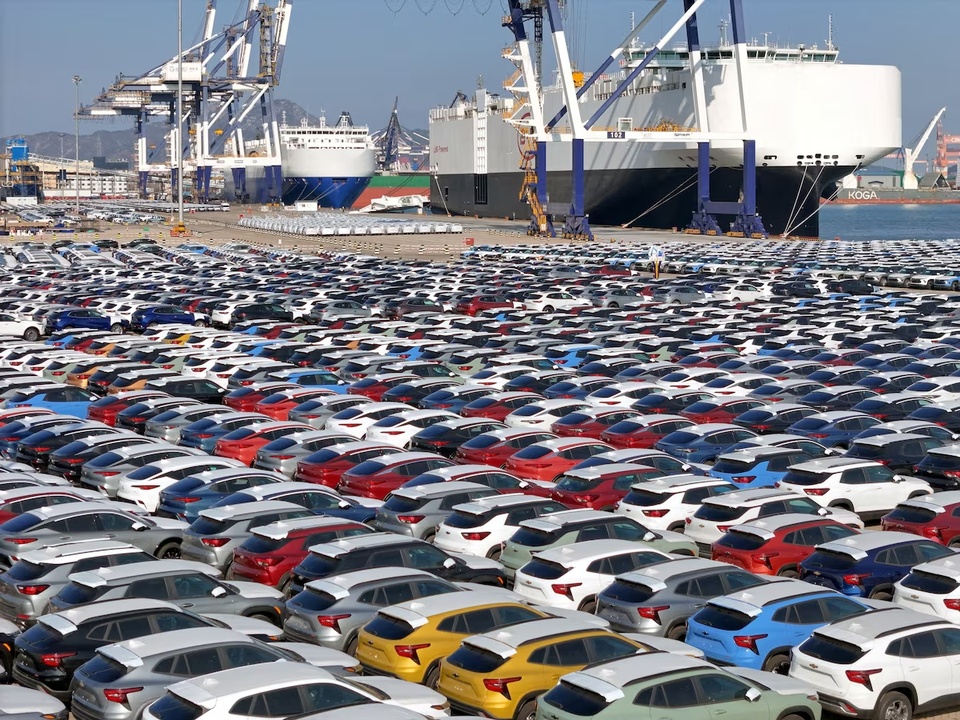
|
|
The automotive industry, worth billions of dollars, is one of the sectors hardest hit by the tariffs. Photo: Reuters. |
On March 4, the US officially imposed a 25% tariff on goods from Canada and Mexico, while increasing the tariff from 10% to 20% on goods from China.
In response to the US tariffs, China and Canada have taken retaliatory measures. Beijing quickly announced import tariffs of 10-15% on many US agricultural and food products. Meanwhile, Ottawa imposed a 25% tariff on $30 billion worth of US goods.
The reciprocal tariff measures between the US, Canada, Mexico, and China have affected hundreds of billions of dollars’ worth of goods across various sectors.
Automotive
President Trump’s 25% tariff on goods from Canada and Mexico will significantly impact the automotive industry, affecting both manufacturers and consumers, due to the large volume of vehicles and parts imported into the US daily to serve the market.
Most recently, White House Press Secretary Karoline Leavitt announced that President Donald Trump has delayed the imposition of import tariffs on cars from Canada and Mexico for another month. After speaking with Ford, General Motors, and Stellantis, Mr. Trump agreed to postpone the tariffs to ensure that the three largest automakers in the US would not suffer financial losses.
For decades, automakers have built supply chains that cross the borders of the US, Mexico, and Canada. According to S&P Global Mobility, more than one-fifth of the cars and light trucks sold in the US are produced in Canada or Mexico.
Last year, the US imported $79 billion worth of cars and light trucks from Mexico – more than from any other country – and $31 billion worth from Canada.
In addition, the US also imported $81 billion worth of automotive parts from Mexico and $19 billion worth from Canada. For example, the engines for Ford’s F-Series pickup trucks and the iconic Mustang sports car are manufactured in Canada, according to AP.
Scott Lincicome, a trade analyst at the Cato Institute, said, “Many components, such as engines, car seats, and other parts, may cross the border multiple times before becoming a finished vehicle. Many parts made in the US are sent to Mexico for assembly into cars, which are then exported back to the US.”
“Imposing a 25% tariff on all these processes is like throwing a grenade into the system,” said Lincicome.
China is also a major supplier of automotive parts to the US, with imports totaling $18 billion last year.
| TOP VEHICLE EXPORTING COUNTRIES TO THE US IN 2023 | |||||||
| Source: The New York Times. | |||||||
| Label | Mexico | Japan | South Korea | Canada | Germany | China | |
| Country | thousands of vehicles | 1980 | 1470 | 1270 | 1240 | 395 | 387.6 |
According to S&P Global Mobility, importers are likely to pass on much of this increased cost to consumers.
TD Economics estimates that car prices in the US could increase by an average of $3,000, while the average price of a new car has already reached nearly $49,000, and used cars also cost around $25,000 on average, according to Kelley Blue Book.
The New York Times reported that car manufacturers are worried about the potential tariffs. Ford CEO Jim Farley stated at an investor conference in February, “Let’s be frank, if a 25% tariff is applied to goods from Mexico and Canada, the US automotive industry will face an unprecedented crisis.”
Agriculture and Food
After the US imposed tariffs, China announced that it would impose tariffs of up to 15% on many food imports from the US, including chicken, wheat, corn, and cotton.
The retaliatory measures also include a 10% tariff on mung beans, soybeans, pork, beef, seafood, fruits, vegetables, and dairy products.
Canada also announced that it would impose retaliatory tariffs of 25% on $20.5 billion worth of US imports. Although the Canadian government has not yet released the list of goods subject to retaliatory tariffs, a proposal from last month listed hundreds of potential US products, including orange juice and peanut butter.
According to data from the US Department of Agriculture, China accounted for 14% of total US agricultural exports in 2024, equivalent to about $24.7 billion. However, Mexico and Canada are even bigger importers, with imports totaling $30.3 billion and $28.4 billion, respectively.
Professor Lynn Kennedy, an agricultural economist at Louisiana State University, said that agricultural products became a target because they account for a large portion of US exports.
| |
|
A corn harvest in a Minnesota farm. Photo: The New York Times. |
Similar to Trump’s first term, these retaliatory tariffs could lead to a decline in US exports and lower agricultural prices, as importers from China, Canada, or Mexico may turn to Brazil or other major agricultural producing countries for alternatives.
According to the US Department of Agriculture, soybeans accounted for half of the total US agricultural exports to China last year. However, US companies have to compete with soybean exporters from Brazil. On March 4, the futures price of US soybeans fell by about 1%, while corn and wheat prices also dropped.
For US consumers – who are already struggling with rising food prices – a trade war with Canada, Mexico, and China could make the situation worse.
Energy and Metals
Canada is currently the largest supplier of crude oil to the US, far surpassing other countries. In 2024, Canada exported $98 billion worth of oil to the US, while Mexico, the second-largest supplier, exported only $12 billion worth.
For many US refineries, replacing Canadian oil is not a viable option.
“Canada produces the type of crude oil that US refineries are designed to process. It’s heavy oil. Meanwhile, most of the oil produced by fracking in the US is light oil, which many refineries, especially in the Midwest, are not equipped to handle,” said Lincicome.
| |
|
US crude oil imports from Canada (red) and other countries (gray) during 1993-2023 (in millions of barrels per day). Chart: EIA. |
Additionally, the metal industry will also be significantly impacted by the reciprocal tariffs among the countries. According to Reuters, the American Iron and Steel Institute (AISI) stated that about a quarter of the steel used in the US in 2024 was imported, amounting to about 28.8 million tons. Canada and Mexico were the top suppliers, with imports totaling $11.2 billion and $6.5 billion, respectively.
Furthermore, about half of the aluminum used in the US is imported, with Canada being the largest supplier. Last year, the US imported 3.2 million tons of aluminum from Canada, double the total imports from the next nine countries combined, worth $9.5 billion.
Computers, Clothing, and Toys
The tariffs on goods imported from China could affect a wide range of essential items that Americans rely on daily. According to data from the US Department of Commerce, mobile phones, computers, and other electronic devices were among the top imports from China last year.
Additionally, the US imported more than $32 billion worth of “toys, games, and sports equipment” from China during the same year.
The fashion industry is also impacted. American consumers spend billions of dollars each year on clothing from China, including more than $7.9 billion on footwear last year.
With its highly open economy, Vietnam cannot escape the impacts of global economic trends. In today’s complex and ever-changing business world, staying updated with international business knowledge and trends has become a pressing need. To help readers access the latest international business insights, Tri Thuc – Znews introduces the World Business Bookshelf, featuring books and stories on global business trends.
The Toy Car Tariff Twist: When Playtime Prices Surge
The iconic Hot Wheels toy cars may soon see a hike in their price tags as President Trump threatens to impose a 100% tariff on their parent company, Mattel. With the potential for a significant increase in production costs, collectors and fans of the tiny vehicles may need to brace themselves for a bumpier ride ahead.
The Automotive Industry in June 2025: A Plethora of New Models Stirring up the Market
The automotive industry in Vietnam is gearing up for an exciting launch in the latter half of June, with two highly anticipated models set to hit the market: the Suzuki Swift and the Skoda Kushaq 2025. These sleek and sophisticated vehicles are poised to revolutionize the local automotive landscape, offering consumers a blend of style, performance, and innovation that is sure to captivate drivers nationwide.
“VinFast Empowers Vietnamese Supporting Industries with Product Support and Assurance”
VinFast, Vietnam’s leading automobile manufacturer, is proud to announce an incredible opportunity for Vietnamese auxiliary businesses. We are offering a substantial incentive of up to 50% discount on land lease fees, along with a guarantee to absorb the output of these auxiliary businesses that join our automotive production chain. This is a testament to our commitment to fostering local industry and empowering Vietnamese enterprises.












































